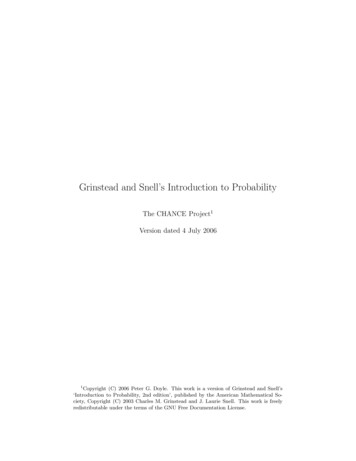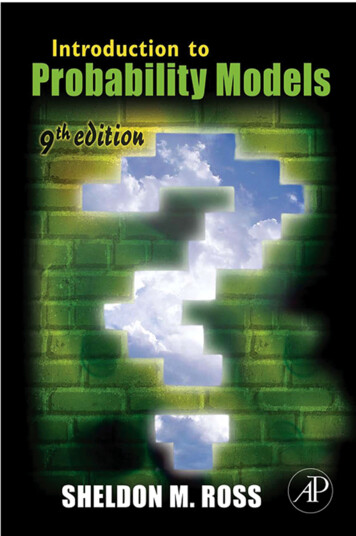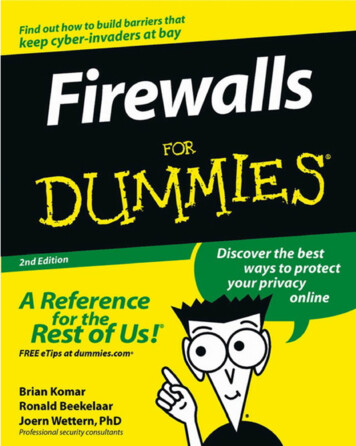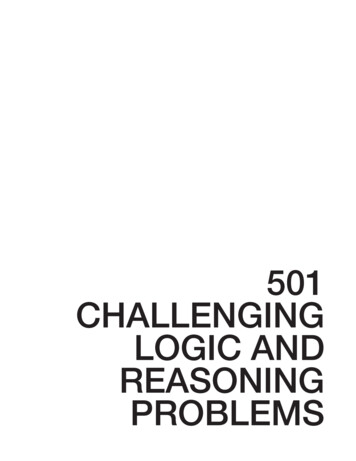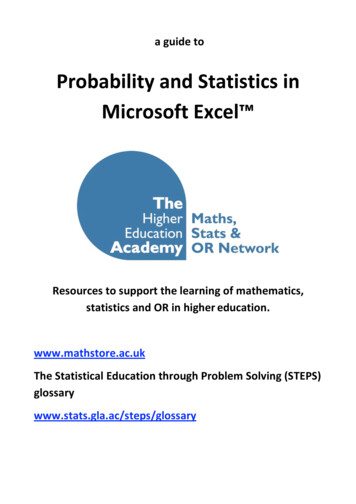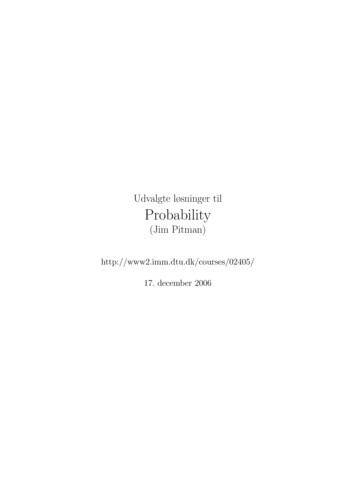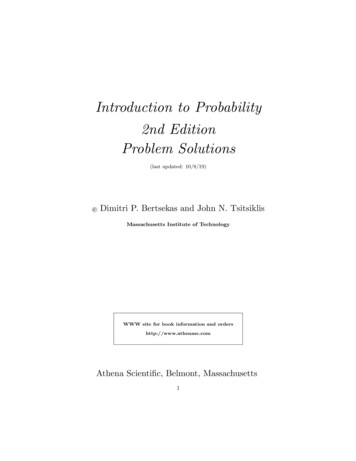
Transcription
Introduction to Probability2nd EditionProblem Solutions(last updated: 10/8/19)cDimitri P. Bertsekas and John N. TsitsiklisMassachusetts Institute of TechnologyWWW site for book information and ordershttp://www.athenasc.comAthena Scientific, Belmont, Massachusetts1
CHAPTER 1Solution to Problem 1.1. We haveA {2, 4, 6},B {4, 5, 6},so A B {2, 4, 5, 6}, and(A B)c {1, 3}.On the other hand,Ac B c {1, 3, 5} {1, 2, 3} {1, 3}.Similarly, we have A B {4, 6}, and(A B)c {1, 2, 3, 5}.On the other hand,Ac B c {1, 3, 5} {1, 2, 3} {1, 2, 3, 5}.Solution to Problem 1.2. (a) By using a Venn diagram it can be seen that for anysets S and T , we haveS (S T ) (S T c ).(Alternatively, argue that any x must belong to either T or to T c , so x belongs to Sif and only if it belongs to S T or to S T c .) Apply this equality with S Ac andT B, to obtain the first relationAc (Ac B) (Ac B c ).Interchange the roles of A and B to obtain the second relation.(b) By De Morgan’s law, we have(A B)c Ac B c ,and by using the equalities of part (a), we obtain(A B)c (Ac B) (Ac B c ) (A B c ) (Ac B c ) (Ac B) (Ac B c ) (A B c ). (c) We have A {1, 3, 5} and B {1, 2, 3}, so A B {1, 3}. Therefore,(A B)c {2, 4, 5, 6},2
andAc B {2},Ac B c {4, 6},A B c {5}.Thus, the equality of part (b) is verified.Solution to Problem 1.5. Let G and C be the events that the chosen student isa genius and a chocolate lover, respectively. We have P(G) 0.6, P(C) 0.7, andP(G C) 0.4. We are interested in P(Gc C c ), which is obtained with the followingcalculation:P(Gc C c ) 1 P(G C) 1 P(G) P(C) P(G C) 1 (0.6 0.7 0.4) 0.1. Solution to Problem 1.6. We first determine the probabilities of the six possibleoutcomes. Let a P({1}) P({3}) P({5}) and b P({2}) P({4}) P({6}).We are given that b 2a. By the additivity and normalization axioms, 1 3a 3b 3a 6a 9a. Thus, a 1/9, b 2/9, and P({1, 2, 3}) 4/9.Solution to Problem 1.7. The outcome of this experiment can be any finite sequenceof the form (a1 , a2 , . . . , an ), where n is an arbitrary positive integer, a1 , a2 , . . . , an 1belong to {1, 3}, and an belongs to {2, 4}. In addition, there are possible outcomesin which an even number is never obtained. Such outcomes are infinite sequences(a1 , a2 , . . .), with each element in the sequence belonging to {1, 3}. The sample spaceconsists of all possible outcomes of the above two types.Solution to Problem 1.8. Let pi be the probability of winning against the opponentplayed in the ith turn. Then, you will win the tournament if you win against the 2ndplayer (probability p2 ) and also you win against at least one of the two other players[probability p1 (1 p1 )p3 p1 p3 p1 p3 ]. Thus, the probability of winning thetournament isp2 (p1 p3 p1 p3 ).The order (1, 2, 3) is optimal if and only if the above probability is no less than theprobabilities corresponding to the two alternative orders, i.e.,p2 (p1 p3 p1 p3 ) p1 (p2 p3 p2 p3 ),p2 (p1 p3 p1 p3 ) p3 (p2 p1 p2 p1 ).It can be seen that the first inequality above is equivalent to p2 p1 , while the secondinequality above is equivalent to p2 p3 .Solution to Problem 1.9. (a) Since Ω ni 1 Si , we haveA n[(A Si ),i 1while the sets A Si are disjoint. The result follows by using the additivity axiom.(b) The events B C c , B c C, B C, and B c C c form a partition of Ω, so by part(a), we haveP(A) P(A B C c ) P(A B c C) P(A B C) P(A B c C c ).3(1)
The event A B can be written as the union of two disjoint events as follows:A B (A B C) (A B C c ),so thatP(A B) P(A B C) P(A B C c ).(2)P(A C) P(A B C) P(A B c C).(3)Similarly,Combining Eqs. (1)-(3), we obtain the desired result.Solution to Problem 1.10. Since the events A B c and Ac B are disjoint, wehave using the additivity axiom repeatedly,P (A B c ) (Ac B) P(A B c ) P(Ac B) P(A) P(A B) P(B) P(A B). Solution to Problem 1.14. (a) Each possible outcome has probability 1/36. Thereare 6 possible outcomes that are doubles, so the probability of doubles is 6/36 1/6.(b) The conditioning event (sum is 4 or less) consists of the 6 outcomes (1, 1), (1, 2), (1, 3), (2, 1), (2, 2), (3, 1) ,2 of which are doubles, so the conditional probability of doubles is 2/6 1/3.(c) There are 11 possible outcomes with at least one 6, namely, (6, 6), (6, i), and (i, 6),for i 1, 2, . . . , 5. Thus, the probability that at least one die is a 6 is 11/36.(d) There are 30 possible outcomes where the dice land on different numbers. Out ofthese, there are 10 outcomes in which at least one of the rolls is a 6. Thus, the desiredconditional probability is 10/30 1/3.Solution to Problem 1.15. Let A be the event that the first toss is a head andlet B be the event that the second toss is a head. We must compare the conditionalprobabilities P(A B A) and P(A B A B). We have P(A B A) P (A B) AP(A) P(A B),P(A)andP(A B A B) P (A B) (A B)P(A B) P(A B).P(A B)Since P(A B) P(A), the first conditional probability above is at least as large, soAlice is right, regardless of whether the coin is fair or not. In the case where the coinis fair, that is, if all four outcomes HH, HT , T H, T T are equally likely, we haveP(A B)1/41 .P(A B)3/431/4P(A B)1 ,P(A)1/22A generalization of Alice’s reasoning is that if A0 , B 0 , and C 0 are events suchthat B 0 C 0 and A0 B 0 A0 C 0 (for example if A0 B 0 C 0 ), then the event4
A0 is at least as likely if we know that B 0 has occurred than if we know that C 0 hasoccurred. Alice’s reasoning corresponds to the special case where A0 A B, B 0 A,and C 0 A B.Solution to Problem 1.16. In this problem, there is a tendency to reason that sincethe opposite face is either heads or tails, the desired probability is 1/2. This is, however,wrong, because given that heads came up, it is more likely that the two-headed coinwas chosen. The correct reasoning is to calculate the conditional probabilityp P(two-headed coin was chosen heads came up) P(two-headed coin was chosen and heads came up).P(heads came up)We haveP(two-headed coin was chosen and heads came up) P(heads came up) 1,31,2so by taking the ratio of the above two probabilities, we obtain p 2/3. Thus, theprobability that the opposite face is tails is 1 p 1/3.Solution to Problem 1.17. Let A be the event that the batch will be accepted.Then A A1 A2 A3 A4 , where Ai , i 1, . . . , 4, is the event that the ith item isnot defective. Using the multiplication rule, we haveP(A) P(A1 )P(A2 A1 )P(A3 A1 A2 )P(A4 A1 A2 A3 ) Solution to Problem 1.18.haveP(A B B) 95 94 93 92· · · 0.812.100 99 98 97Using the definition of conditional probabilities, weP(A B B)P(A B) P(A B).P(B)P(B)Solution to Problem 1.19. Let A be the event that Alice does not find her paperin drawer i. Since the paper is in drawer i with probability pi , and her search issuccessful with probability di , the multiplication rule yields P(Ac ) pi di , so thatP(A) 1 pi di . Let B be the event that the paper is in drawer j. If j 6 i, thenA B B, P(A B) P(B), and we haveP(B A) P(A B)P(B)pj .P(A)P(A)1 pi d iSimilarly, if i j, we haveP(B A) P(A B)P(B)P(A B)pi (1 di ) .P(A)P(A)1 pi d iSolution to Problem 1.20. (a) Figure 1.1 provides a sequential description for thethree different strategies. Here we assume 1 point for a win, 0 for a loss, and 1/2 point5
2- 0pw1- 0pwpd0.5- 0.51- pwBold playpdBold play1- pdTimid play1- 10- 01- 10.5- 1.50- 01- pw0- 11- pdTimid play1- 1pwpd0- 11- pwBold play1- pdTimid play0- 2(a)0.5- 1.50- 2(b)pd1- 0pw1.5- 0.51- pdTimid play1- 10- 0Bold play(c)1- pwpw0- 11- 11- pwBold play0- 2Figure 1.1: Sequential descriptions of the chess match histories under strategies(i), (ii), and (iii).for a draw. In the case of a tied 1-1 score, we go to sudden death in the next game,and Boris wins the match (probability pw ), or loses the match (probability 1 pw ).(i) Using the total probability theorem and the sequential description of Fig. 1.1(a),we haveP(Boris wins) p2w 2pw (1 pw )pw .The term p2w corresponds to the win-win outcome, and the term 2pw (1 pw )pw corresponds to the win-lose-win and the lose-win-win outcomes.(ii) Using Fig. 1.1(b), we haveP(Boris wins) p2d pw ,corresponding to the draw-draw-win outcome.(iii) Using Fig. 1.1(c), we haveP(Boris wins) pw pd pw (1 pd )pw (1 pw )p2w .6
The term pw pd corresponds to the win-draw outcome, the term pw (1 pd )pw corresponds to the win-lose-win outcome, and the term (1 pw )p2w corresponds to lose-winwin outcome.(b) If pw 1/2, Boris has a greater probability of losing rather than winning any onegame, regardless of the type of play he uses. Despite this, the probability of winningthe match with strategy (iii) can be greater than 1/2, provided that pw is close enoughto 1/2 and pd is close enough to 1. As an example, if pw 0.45 and pd 0.9, withstrategy (iii) we haveP(Boris wins) 0.45 · 0.9 0.452 · (1 0.9) (1 0.45) · 0.452 0.54.With strategies (i) and (ii), the corresponding probabilities of a win can be calculatedto be approximately 0.43 and 0.36, respectively. What is happening here is that withstrategy (iii), Boris is allowed to select a playing style after seeing the result of the firstgame, while his opponent is not. Thus, by being able to dictate the playing style ineach game after receiving partial information about the match’s outcome, Boris gainsan advantage.Solution to Problem 1.21. Let p(m, k) be the probability that the starting playerwins when the jar initially contains m white and k black balls. We have, using thetotal probability theorem,p(m, k) mkk p(m, k 1).1 p(m, k 1) 1 m km km kThe probabilities p(m, 1), p(m, 2), . . . , p(m, n) can be calculated sequentially using thisformula, starting with the initial condition p(m, 0) 1.Solution to Problem 1.22. We derive a recursion for the probability pi that a whiteball is chosen from the ith jar. We have, using the total probability theorem,pi 1 m1mm 1pi (1 pi ) pi ,m n 1m n 1m n 1m n 1starting with the initial condition p1 m/(m n). Thus, we havep2 1mmm· .m n 1 m nm n 1m nMore generally, this calculation shows that if pi 1 m/(m n), then pi m/(m n).Thus, we obtain pi m/(m n) for all i.Solution to Problem 1.23. Let pi,n i (k) denote the probability that after k exchanges, a jar will contain i balls that started in that jar and n i balls that started inthe other jar. We want to find pn,0 (4). We argue recursively, using the total probability7
theorem. We have1 1· · pn 1,1 (3),n nn 1 12 2pn 1,1 (3) pn,0 (2) 2 ·· · pn 1,1 (2) · · pn 2,2 (2),nnn n1 1pn,0 (2) · · pn 1,1 (1),n nn 1 1pn 1,1 (2) 2 ·· · pn 1,1 (1),nnn 1 n 1·· pn 1,1 (1),pn 2,2 (2) nnpn 1,1 (1) 1.pn,0 (4) Combining these equations, we obtain1pn,0 (4) 2n 4(n 1)24(n 1)21 n2n4n4 1 2n 8(n 1)21 n2n4 .Solution to Problem 1.24. Intuitively, there is something wrong with this rationale.The reason is that it is not based on a correctly specified probabilistic model. Inparticular, the event where both of the other prisoners are to be released is not properlyaccounted in the calculation of the posterior probability of release.To be precise, let A, B, and C be the prisoners, and let A be the one who considersasking the guard. Suppose that all prisoners are a priori equally likely to be released.Suppose also that if B and C are to be released, then the guard chooses B or C withequal probability to reveal to A. Then, there are four possible outcomes:(1) A and B are to be released, and the guard says B (probability 1/3).(2) A and C are to be released, and the guard says C (probability 1/3).(3) B and C are to be released, and the guard says B (probability 1/6).(4) B and C are to be released, and the guard says C (probability 1/6).Thus,P(A is to be released and guard says B)P(guard says B)1/32 .1/3 1/63P(A is to be released guard says B) Similarly,2.3Thus, regardless of the identity revealed by the guard, the probability that A is releasedis equal to 2/3, the a priori probability of being released.P(A is to be released guard says C) Solution to Problem 1.25. Let m and m be the larger and the smaller of the twoamounts, respectively. Consider the three eventsA {X m),B {m X m),8C {m X).
Let A (or B or C) be the event that A (or B or C, respectively) occurs and you firstselect the envelope containing the larger amount m. Let A (or B or C) be the eventthat A (or B or C, respectively) occurs and you first select the envelope containing thesmaller amount m. Finally, consider the eventW {you end up with the envelope containing m}.We want to determine P(W ) and check whether it is larger than 1/2 or not.By the total probability theorem, we haveP(W A) 111P(W A) P(W A) (1 0) ,222 11P(W B) P(W B) (1 1) 1,22 111P(W C) P(W C) (0 1) .P(W C) 222Using these relations together with the total probability theorem, we obtainP(W B) P(W ) P(A)P(W A) P(B)P(W B) P(C)P(W C) 11 P(A) P(B) P(C) P(B)2211 P(B).22Since P(B) 0 by assumption, it follows that P(W ) 1/2, so your friend is correct.Solution to Problem 1.26. (a) We use the formulaP(A B) P(A B)P(A)P(B A) .P(B)P(B)Since all crows are black, we have P(B) 1 q. Furthermore, P(A) p. Finally,P(B A) 1 q P(B), since the probability of observing a (black) crow is notaffected by the truth of our hypothesis. We conclude that P(A B) P(A) p. Thus,the new evidence, while compatible with the hypothesis “all cows are white,” does notchange our beliefs about its truth.(b) Once more,P(A C) P(A C)P(A)P(C A) .P(C)P(C)Given the event A, a cow is observed with probability q, and it must be whi
08.10.2019 · Introduction to Probability 2nd Edition Problem Solutions (last updated: 10/8/19) c Dimitri P. Bertsekas and John N. Tsitsiklis Massachusetts Institute of Technology WWW site for book information and orders
